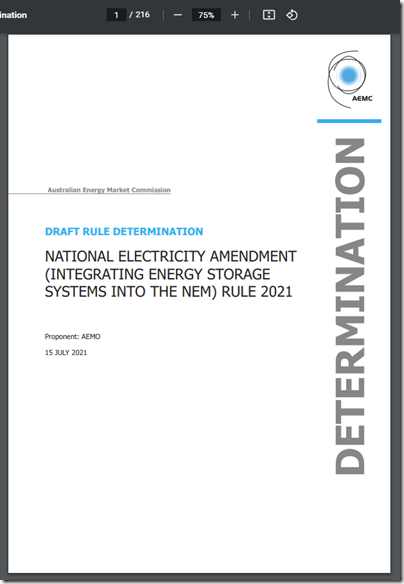Yesterday I posted a quick note about the AEMC’s Final Rule on Fast Frequency Response.
The other development yesterday was this draft rule determination relating to the integration of Energy Storage Systems (i.e. batteries and others) into the NEM:
For more information and contact details, visit the Integrating Energy Storage project page.
(A) Key dates in a timeline
Scanning quickly through this rule change the following seem to be the key milestones in the process, in reverse chronological order:
| Key Date in the process | Quick notes |
| 28th April 2023 perhaps* |
A requirement on AEMO such that they change the registration of existing batteries (i.e. registered as Generator + Load currently) to the new ‘Integrated Resource Provider’ category within 6 months of the commencement date. |
| 28th April 2023 perhaps* |
Implementation is 18 months for Integrating energy storage systems, which if the final determination is published on 28 October as planned, the changes will take effect from 28 April 2023. Paragraph 15 in the Executive Summary also says:
|
| 28th October 2021 perhaps * |
AEMC expects that the Final Determination will be made on 28th October 2021. * The two dates above in this table flow from that. |
| 16th September 2021 |
Submissions on this draft determination are due at the AEMC. |
| mid August 2021 |
The project team will hold a briefing session in early to mid-August. |
| 15th July 2021 (yesterday) |
The AEMC published the Draft Determination. |
| 11th February 2021 |
Submissions to the Options Paper closed. |
| 17th December 2021 |
The AEMC published this Options Paper, seeking further stakeholder feedback on both the participation and non-energy costs recovery frameworks. |
| 15th October 2021 |
Submissions to the Consultation Paper closed – the AEMC received 38 submissions. |
| 20th August 2020 |
The AEMC released this Consultation Paper to seek feedback on the significance of the issues identified by AEMO and whether these are likely to become more material in the future. This helped the Commission understand the importance and urgency of the issues, and whether they required a regulatory solution.. |
| 23rd August 2019 |
This process formally started with AEMO’s rule change request of 23rd August 2019. |
(B) Questions I have – prior to reviewing the Draft Determination?
At this point I have done no more than a very brief scan – so in no way should the following be misconstrued as comments on what’s in the draft determination (as I can’t even say that I know that!).
When I do find time to consider in more detail I do have a number of questions that occur to me – on the assumption that there would no longer be a paired set of DUIDs (i.e. a supply-side Generator, and a demand-side Load):
Q1) How would bids work?
If there is to be only a single DUID for a battery, presumably there will be positive values and negative values offered. What are the details of this?
How does this work within NEMDE.
What would we need to do (e.g. in our ez2view software) to help people make sense of it all?
Q2) How would dispatch work?
Following from the above, if there is a single DUID representing a battery, how would dispatch work (i.e. presumably a positive and negative target, depending on direction of energy flow)?
If this change is going to be made, what implications are there for all systems (like ez2view, but also including dispatch systems and others?) that have been constructed on the assumption that Target would never be negative?
Q3) How would FCAS cost recovery work?
On this ‘FCAS’ page in the evolving WattClarity glossary we’ve added in some details of how cost recovery currently works – for both Regulation and Contingency (Raise separate to Lower). If this new registration category will encompass both Generator and Wholesale Customer component, how does Contingency cost recovery change?



Be the first to comment on "AEMC published Draft Rule on Energy Storage Systems"